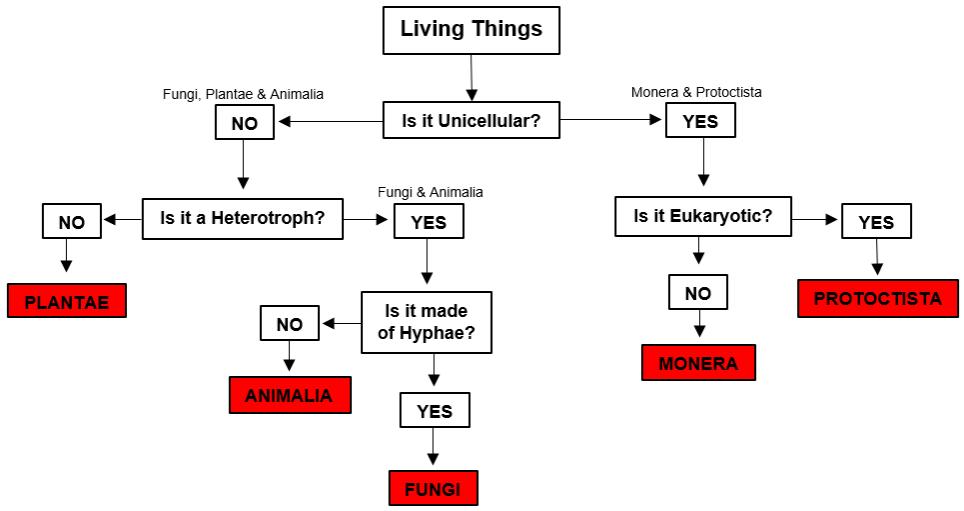7 Characteristics of all Living Things
The acronym: MRS GREN shows the 7 characteristics that all living things show to be considered as living.
- Movement: an action by an organism or part of an organism causing a change of position or place
- Respiration: the chemical reactions in cells that break down nutrient molecules and release energy for metabolism
- Sensitivity: the ability to detect or sense stimuli in the internal or external environment and to make appropriate responses
- Growth: a permanent increase in size and dry mass by an increase in cell number or cell size or both
- Reproduction: the processes that make more of the same kind of organism
- Excretion: removal from organisms of the waste products of metabolism (chemical reactions in cells including respiration), toxic materials, and substances in excess of requirements
- Nutrition: taking in of materials for energy, growth and development; plants require light, carbon dioxide, water and ions; animals need organic compounds and ions and usually need water
Other than these 7 characteristics of living things, to be considered living, an organism must have cells present. These cells will contain:
- A cell membrane
- A cytoplasm
- DNA as genetic material
- Ribosomes for protein synthesis
- and Enzymes for respiration.
Classification
The science of placing organisms into categories on the basis of observable characteristics is called classification. Organisms can be classified into groups by the features that they share. Classification is traditionally based on morphology (the study of form or characteristics from the outside of an organism) and anatomy (the study of the inside of an organism).
Today, the more accurate means of classification is the sequence of bases in DNA(deoxyribonucleic acid) and of amino acids in proteins. Organisms which share a more recent ancestor (are more closely related) have base sequences in DNA that are more similar than those that share only a distant ancestor.
Classification of organisms is necessary:
- It can help identify an organism or the group it belongs to and accordingly predict an organism’s behaviour or know if the organism is endangered or at the verge of extinction
- It can help reflect and study evolutionary relationships (cladistics)
- It can help understand relationships between multiple organisms in the same group of classification.
The Hierarchy of Classification
There are many different organisms on the plant. Taxonomists (the scientists who study classification – taxonomy), have placed these organisms in several different kingdoms as they get discovered based on similar characteristics and DNA. As there are so many organisms in kingdoms, there are further classification groups (phylum) and subgroups (class). Additionally, there is order, family and genus. Finally, the basic unit of classification, which is also the last and final level, is species. A species is a group of organisms that can reproduce to produce fertile offspring.
The Binomial Nomenclature
The binomial system of naming species is an internationally agreed system in which the scientific name of an organism is made up of two parts showing the genus and species. This name of the genus and specie forms a scientific name. There are 2 main rules to be acknowledged when writing these names:
- The genus name must start in capital, and the specie name in small (Panthera Leo – lion)
- The words must be underlined separately when written (Panthera tigris – tiger) or in italics when typed on a device (Panthera pardus – leopard)
Infertile Offspring
When a male tiger and a female lion breed, an infertile or sterile offspring (tigon) is formed or when a male lion and female tiger breed a liger is formed. They are infertile as their parents are different species, but their parents can breed as they belong to the same genus. Similarly, a horse and a donkey can breed and a mule will be the offspring.
5 Kingdom Classification
There are 5 Kingdoms in which organism have been placed so it is easy to identify and classify them. These kingdoms are:
- Kingdom Monera / Prokaryotae (Bacteria)
- Kingdom Protista / Protoctista (Protoctists)
- Kingdom Fungi (Fungi)
- Kingdom Plantae (Plants)
- Kingdom Animalia (Animals)
in evolutionary order.
Viruses are no considered to be a part of any kingdom as of now as they only show living characteristics inside a host (parasite). They are known as entities.
Kingdom Monera
This is the first and most primitive kingdom out of all the 5 kingdoms. Bacteria are single celled prokaryotes (scattered nuclear matter) and they do not have some cell organelles. All monerans have a peptidoglycan cell wall. They make their own food using chemicals in the surroundings (chemoautotrophs).
Kingdom Protoctista
Protoctists are also unicellular organisms, but they have a well-defined nucleus (eukaryotic). Each protoctist has a specific organelle for locomotion.
Kingdom Fungi
Most fungi are either parasitic (feed on a host) or saprophytic (feed on dead or decaying organisms). They are multicellular (except yeasts) and are made up of thread like structures called hyphae which bunch together to form mycelium. They digest their food outside their body (extracellular digestion). Finally, they have a chitin cell wall.
Kingdom Plantae
A plant has a cell wall made out of cellulose and produces its own food in the presence of light (photosynthesis). They are photo-autotrophs. As there are many different plants, they are classified in 4 groups:
- Algae
- Mosses
- Ferns
- Seed Plants (Gymnosperms and Angiosperms)
Ferns: Ferns have leaves, stems and roots; they reproduce with spores present on the lower surface of their leaves; they also have vascular tissues (xylem and phloem) present in their stems; they have an underground stem that can survive when fronds (complex leaves) die. This stem is called the rhizome.
Angiosperms: These are seed plants which have seeds present in fruits which are developed from flowers. Thus, these plants are also called flowering plants. They have roots, stems, leaves, vascular tissues, flowers, fruits and stomata. They are further classified into monocotyledons (1 cot) and dicotyledons (2 cots).
There are multiple differences between these two angiosperms. Some of them are mentioned here:
- Monocots have 1 cot and dicots have 2
- Monocots have 1 seed leaf and dicots have 2
- Monocots show parallel venation and dicots show reticulate or branched venation
- Monocots have long and narrow leaves and dicots have short and broad leaves
- Monocot germination is hypogeal and dicots is epigeal
- Monocots have fibrous roots and dicots have tap roots
Kingdom Animalia
Animals are the most numerous kingdom from the 5 kingdoms and thus they have 9 phyla. These phyla are: porifera (sponges), cnidaria (jellyfish and corals), platyhelminthes (tapeworm), nematoda(roundworms), annelida (earthworms), mollusca (snails), arthropoda (4 sub-groups), echinodermata(starfish) and chordata (5 sub-groups) in evolutionary order.
Arthropoda: arthropods mean ‘jointed limbs.’ Each arthropod has several pairs of jointed limbs. There are 4 sub-groups of arthropods:
- Insecta: 6 legs or 3 pairs of jointed legs; clear head, thorax and abdomen; specialised mouthparts for feeding; antennae to sense stimuli in the surroundings; compound eyes; most have 2 pairs of wings for flying (ants don’t have wings, some have 1 pair); shows metamorphosis – using the surrounding environment to the maximum to change body form (caterpillar to butterfly)
- Arachnida: 8 legs or 4 pairs of jointed legs to chase pray or hold onto a web; piercing jaws; clear division of head and cephalothorax; 4 simple eyes to detect pray; spinneret produces long, thin strands of silk.
- Crustacea: 10 legs or 5 pairs of jointed legs; gills under shell to breathe underwater; calcareous carapace for protection; eyes to see in the aquatic environment; hard and strong claw to hold food and break mollusc shells.
- Myriapoda: Numerous pairs of jointed legs (1 pair per segment – centipede, 2 pairs per segment – millipede); many body segments; antennae as sense organs in the dark and damp environment; hard exoskeleton for protection; waterproof body; legs to walk over rough surfaces; mouthparts have hard edges to bite vegetation (millipedes) or animals (centipedes).
Chordata: All chordates have a vertebral column and are also called vertebrates. There are 5 classes under this phylum: Fish, amphibians, reptiles, birds and mammals in evolutionary order.
- Fish: have fins for movement and stability; scales covered in mucus help streamlining for swimming; lateral line contains sense organs to detect vibrations; operculum (in bony fish) covers gills or gill slit (in cartilaginous fish); gills have a large surface area for gas exchange; cold blooded (poikilothermic); gills are red as there are blood vessels present.
- Amphibians: moist skin for gas exchange under water (no body covering henceforth); nostrils lead to lungs for gas exchange on land; wide mouth as adult amphibians are all carnivores; four limbs with webbed hind limbs for walking and swimming; poikilothermic; tympanum (eardrum) visible with no auditory canal.
- Reptiles: dry, scaly skin to prevent water loss; tail used for swimming (crocodiles and more); limbs efficient for crawling and climbing; mouth has teeth or bony ridges to aid feeding; poikilothermic; auditory canal leads to eardrum; moult skin (shed and regrow the skin).
- Birds: forelimbs are modified as wings; nostril leads to lungs for gas exchange; endothermic (warm blooded); feathers are vital for flight and endothermy (keeping warm); light beak with no bone or teeth (helps in flying without weight); scales on legs; feet ideal for perching (holding onto branches or support); lay calcareous eggs; hollow bones – make them lighter.
- Mammals: presence of mammary glands – milk secreting organs; fur or hair as a body covering for endothermy as mammals need to maintain body temperature; pinna (external ear) is present; whiskers are sensitive to touch or vibration; mouth contains various types of teeth allows mammals to have a wide variety of food; penis in males to ensure fertilisation; diaphragm helps in breathing as it separates thorax and abdomen; viviparous (give birth – except ducked billed platypus, lays eggs).
Viruses
A virus does not show living characteristics unless it is living inside a host. A virus has a protein coat which protects the genetic material and is made up of many subunits and a single strand of genetic material which is either DNA or RNA (ribonucleic acid).
Dichotomous Keys

▲ The above key is called a branching key or a dichotomous key (as there are 2 possible answers to a question – yes or no). It asks a series of questions to classify.
Characteristics and Classification of Living Things FAQs
Characteristics of Living Things
What are the characteristics of living things?
Scientists use a set of common characteristics to distinguish living organisms from non-living things. While different sources may list slightly varying numbers (commonly 5, 6, 7, or 8), the core ideas are similar.
What are some common characteristics used to define living things?
Key characteristics typically include:
- **Organization (made of cells):** All living things are composed of one or more cells, the basic unit of life.
- **Metabolism:** Living things obtain and use energy to carry out chemical processes (like obtaining nutrients and eliminating waste).
- **Growth and Development:** Organisms grow (increase in size) and develop (undergo changes over their life cycle).
- **Adaptation:** Living things evolve over time to better survive in their environment.
- **Response to Stimuli:** Organisms react to changes in their environment.
- **Reproduction:** Living things produce new organisms like themselves, either sexually or asexually.
- **Regulation/Homeostasis:** Organisms maintain stable internal conditions despite external changes.
- **Heredity:** Living things pass on traits to their offspring through genetic material (DNA or RNA).
Do all living things exhibit ALL these characteristics at all times?
Most individual living organisms exhibit most or all of these characteristics over their lifetime. However, not every single characteristic needs to be displayed by an individual at every single moment (e.g., a mature organism might not be currently growing or reproducing). Some characteristics, like adaptation, apply more to a species or population over generations (evolution).
Which characteristics of living things do viruses exhibit? Are viruses considered living?
Viruses exhibit some characteristics of living things, notably:
- **Heredity:** They contain genetic material (DNA or RNA) that dictates their structure and function.
- **Adaptation/Evolution:** They can mutate and evolve over time.
However, viruses lack several other key characteristics. They are not made of cells, cannot carry out metabolism independently, and cannot reproduce without hijacking a host cell's machinery. Because they lack several fundamental traits, viruses are often considered to be on the boundary between living and non-living, and most scientists do not classify them as living organisms.
Classification of Living Things (Taxonomy)
What is the classification of living things? What is it called?
The classification of living things is the science of grouping organisms based on shared characteristics. This system is called **Taxonomy**. It provides a hierarchical structure for organizing the vast diversity of life on Earth.
Why is classifying living things important?
Classification is important for several reasons:
- **Organization:** Helps scientists organize and understand the millions of known species.
- **Understanding Relationships:** Shows the evolutionary relationships between different groups of organisms.
- **Communication:** Provides a universal naming system (Binomial Nomenclature) so scientists worldwide can refer to the same organism unambiguously.
- **Predictive Value:** Grouping organisms based on characteristics allows scientists to predict traits of newly discovered organisms.
What are the main levels (hierarchy) of classification? What is the order?
The main hierarchical ranks, from broadest to most specific, are:
- **Domain**
- **Kingdom**
- **Phylum**
- **Class**
- **Order**
- **Family**
- **Genus**
- **Species**
Organisms grouped at higher levels (like Domain) share very general characteristics, while those at lower levels (like Species) are very similar.
Who developed the modern system of classification?
The Swedish botanist and zoologist **Carl Linnaeus** (1707-1778) is considered the father of modern taxonomy. He developed the system of hierarchical classification and binomial nomenclature (the two-part scientific naming system, like *Homo sapiens*).





